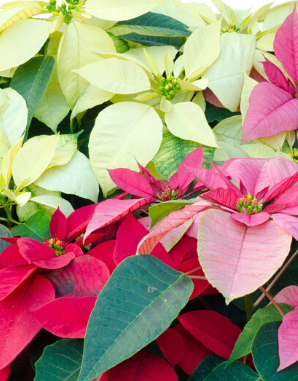
Three Little Known Facts About Poinsettias
Allow Us to Share the Finer Points
It’s time for a pointed conversation about poinsettias. As you begin to deck the halls with the ubiquitous holiday plant, you might be surprised to learn the poinsettia is shrouded in misconceptions. For example, did you know the poinsettia’s flower is actually the clustered yellow buds at the center, not the colored leafy parts (which are called bracts)?
That’s just the tip of the iceberg. Get ready for some fascinating and festive facts that will help you make the right decisions for your property’s holiday décor, or at least enhance your cocktail party conversation.
They’re Not Lethal
First, let’s tackle the most common myth about poinsettias: they’re not deadly. That said, if enough is ingested, it can cause an upset digestive or skin irritation. Luckily, most children and pets aren’t any more interested in eating a poinsettia than they are any other plant. In the event they were, they’d have to eat hundreds of leaves to have a harmful effect.

But what about touching a poinsettia, or simply being in their presence? For most people, it’s not a problem; however, for those with a latex allergy, coming in contact with a poinsettia’s milky sap or inhaling it can cause an allergic reaction. This happens because poinsettias hail from the same plant family as Brazilian rubber trees and contain two of the same proteins found in natural rubber latex. The good news is the sap isn’t released unless a leaf is pulled off, or the plant is broken in some manner. Walking past a poinsettia isn’t likely to be an issue. However, if your property is frequented by individuals with severe latex allergies, talk with your landscape partner about how to minimize risk.
They Come in a Rainbow of Colors
Red and white poinsettias may be the classic holiday offering, but they’re not the only options. Poinsettias come in over 100 different colors, including pink, purple, orange, and yellow. You can also find marbled varieties and ones with contrasting edging. And yes, you can even find blue poinsettias, though their azure hue is artificially induced with dye. Whatever you fancy, the broad offerings provide more opportunity to customize your holiday décor to complement your property, stay on brand, and cultivate unique curb appeal.
They’re Not Just a Holiday Plant
Poinsettias are actually a sub-tropical plant, native to southern Mexico. In the wild, they can grow to up to 12 feet tall. If you’re in a region that experiences warm winters (zones 10 and higher), poinsettias can be grown as a perennial and enjoyed all year long. Once the risk of frost has past, poinsettias can be transplanted to the ground, in a spot with well-drained soil, abundant sun, and plenty of shade in the afternoon. Poinsettias need a sizeable amount of water, but the tradeoff is lush greenery.
For the rest of us, poinsettias can be enjoyed past the holidays indoors, and can stay in bloom for as long as 6 months. The key is keeping the soil moist (but never soggy), and providing a location with abundant natural sunlight and a temperature that consistently stays between 60 – 70 degrees Fahrenheit.
While that’s easy enough, getting a poinsettia to bloom again—no matter where you’re located—is best left to the professionals. Most poinsettias have been manipulated by growers to force blooming during the holidays. Replicating this process would require ensuring the plant receives sunlight for no more than 10-12 hours, followed by 12-14 hours of darkness daily, for 10 consecutive weeks.



